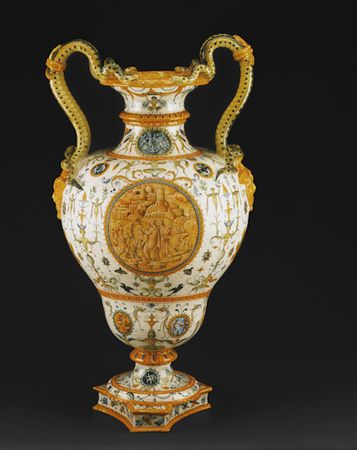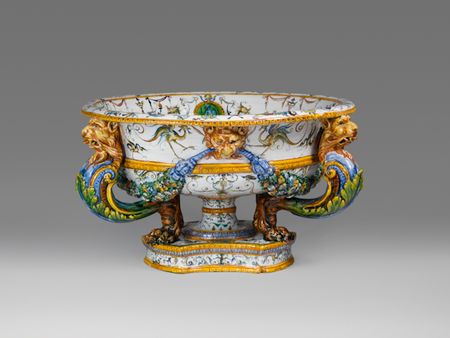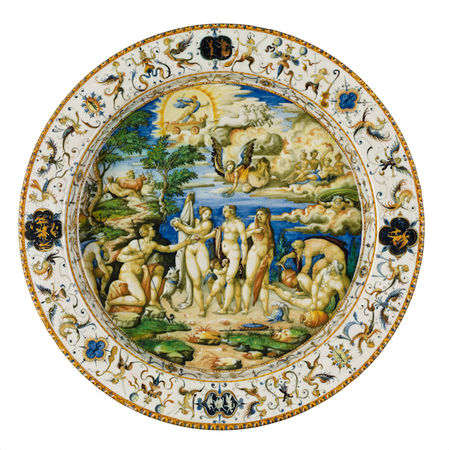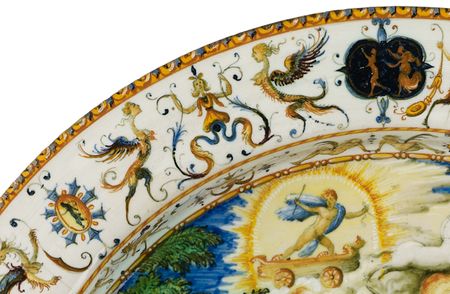'Exuberant Grotesques: Renaissance Maiolica from the Fontana Workshop' @ the Frick Collection
Vase, Biblical Scenes from the Old Testament, Urbino or Turin, c. 1565, workshop of Orazio Fontana, tin-glazed earthenware, 21 1/4 x 11 3/16 inches, Philadelphia Museum of Art, Purchased with the Bloomfield Moore Fund and other Museum funds, 1944
Exuberant Grotesques: Renaissance Maiolica from the Fontana Workshop is the latest in a critically acclaimed series of dossier presentations organized by the Frick. The project takes a rare focused look at this family workshop by presenting several outstanding and innovative examples of sixteenth-century Italian maiolica dating between 1565 and 1575. Each object features the distinctive combination of a central narrative istoriato scene surrounded by delicate grotesques on a white ground. The incorporation of these grotesques, used first in the Renaissance on the walls of the Vatican loggias painted by Raphael in 1519, was translated in Urbino to the ornamentation of luxury maiolica wares. For fifty years, from 1560 to the beginning of the seventeenth century, they were considered the most fashionable decoration to be found on these ceramics. The best pieces, including the six presented in the exhibition, are usually attributed to the workshop of Orazio Fontana, one of the most renowned Italian potters of the Renaissance, who seems to have specialized in the genre. Featuring works from the holdings of The Metropolitan Museum of Art, the Philadelphia Museum of Art, and the Frick, the exhibition is organized by Charlotte Vignon, the sixth Andrew W. Mellon Curatorial Fellow, who was recently appointed as the Frick’s first Associate Curator of Decorative Arts. She comments, “It has given me great pleasure to examine this captivating, but somewhat overlooked, subject. Indeed, while visible in the permanent collection galleries of many museums today, maiolica seldom has been the sole focus of an exhibition, and rarer still is the opportunity to consider the production of one workshop in particular. In fact, we believe this to be the first presentation yet to explore just the output of the Fontana family, and we hope that it will offer visitors today a renewed appreciation for these magnificent wares.” Exuberant Grotesques: Renaissance Maiolica from the Fontana Worship is made possible by The Andrew W. Mellon Foundation and The Gladys Krieble Delmas Foundation. The accompanying catalogue has been generously underwritten by the Robert H. Smith Family Foundation. Education programs planned include a lecture and seminar.
COLLECTED OVER THE CENTURIES
Highly valued in its day, Renaissance maiolica rarely, if ever, served a utilitanian purpose. Indeed, these dishes, vases, and basins were intended to be seen as part of larger services to be displayed together on sideboards. As contemporary works, they provided impressive evidence of taste and wealth. During the seventeen century, the acquisition of older maiolica was restricted to a few influential collectors scattered throughout Europe, including Queen Christina of Sweden (1616–1662) and Cardinal Mazarin (1602–1661), an interest that spread throughout the continent by the beginning of the next century. For early generations of enthusiasts, these ceramics were believed to be the work of the most significant Italian artists of the Renaissance, such as Raphael, whose name became so closely associated with the pottery that it was commonly called “Raphael ware” in Britain until the middle of the nineteenth century. Grotesques were often attributed to his student Giovanni da Udine, while the istoriati scenes were frequently credited to Vasari, Tintoretteo, or Titian. With such illustrious attributions, maiolica began to be associated with the Old Masters collected by the greatest art lovers of the time, and the most beautiful dishes featuring an istoriato scene were housed in rich frames, for display alongside Old Master paintings. One notable exception to this installation practice was the collection of Sir Andrew Fountaine (1676–1753), who displayed in a single room at his Norfolk estate nearly two hundred pieces purchased directly from Cosimo III de Medici, grand duke of Tuscany. Here, maiolica was shown in a single room, in the manner that Asian porcelains were displayed at the time in a devoted “China Room.” During the second half of the eighteenth-century, at a time when British gentlemen traveled to Italy for their obligatory Grand Tour, maiolica received praise for its association with antiquity, in many cases the connection deriving from shape as much as ornamentation. In the next century, when British and French romantics attempted to revive the medieval period by creating “Gothic” interiors, they displayed maiolica in a different context, placing them with other applied arts ranging in period from the Middle Ages to the late Renaissance.
With the emergence of industry as a powerful economic force, public institutions and museums became a repository of models for the instruction of craftsmen and designers. Maiolica was then viewed as a potential model for modern industrial arts as well as a subject for scholarly study. John Charles Robinson, curator of the London institution later renamed the Victoria and Albert Museum, championed the wares and included them in an 1862 exhibition of decorative arts from the medieval through Renaissance periods. Many examples from the Fontana workshop were incorporated, including two of the objects featured in the Frick’s exhibition. Among the principal lenders to that show were two members of the Rothschild family, Sir Anthony de Rothschild and Baron Lionel de Rothschild. A third Rothschild, Adolphe (1823–1900), expressed his enthusiasm for maiolica by displaying his vast Paris collection in a private “museum” separated from the rest of the house, an approach that demonstrated his understanding of the status of each object and his pride as a collector. The Frick exhibition also reunites four objects from this great collection, its own charger and three Philadelphia vases.
Nineteenth-century sales of well-known art collections inevitably brought many fine examples of maiolica to the United States. The principal buyers were art dealers, who sold these objects to wealthy American clients, many of whom found great appeal in sixteenth-century Italian art, relating themselves to the wealthy prince-merchants of the Renaissance who had also built financial empires, managed governments, and patronized the arts and crafts. Among these were examples from Adolphe de Rothschild’s collection, which eventually passed through the hands of celebrated art dealer Joseph Duveen to collectors such as Robert Lehman (1891–1969) and William Randolph Hearst (1863–1951). However, most of the maiolica, and not the least important, stayed in Duveen’s stock until it was sold to Norton Simon in 1964, when the millionaire industrialist purchased the remaining holdings of the dealership. One striking example from this group is the very piece that inspired this exhibition, a large charger made in Urbino around 1565 in the workshop of the Fontana, which was given recently to The Frick Collection by Dianne Dwyer Modestini in memory of her husband Mario Modestini.
DECORATIVE SPLENDOR SURPASSING THE ANCIENTS
During the late fifteenth and early sixteenth century, Italian potters developed the techniques that transformed maiolica from simple tin-glazed earthenware pieces into elaborate works of art that attracted the attention of the most discriminating patrons. Maiolica wares were prized not for the materials from which they were made, but rather for the technical achievement demonstrated in their creation and decoration. They had complex shapes, were surprisingly light, and were white in color, properties that made them comparable to Oriental porcelain, which had long been valued by European collectors. It was, however, the detailed narrative scenes painted on the finest pieces that charmed the most eminent princes, dukes, and cardinals of the day. These scenes, called in Italian istoriati, were applied in a rich and varied palette of colors, demonstrating a proficiency not achieved by even the Greeks or the Romans. With these works, Italian Renaissance potters realized the ultimate goal of every Renaissance craftsman and artist: not only to rival the ancients, but to surpass them.
THE FONTANA WORKSHOP
Orazio Fontana (1510–1571) trained with his father, Guido Durantino, who owned an important workshop in Urbino, Italy, that attracted the era’s most talented maiolica painters. In 1565, at the age of fifty-five, Orazio opened his own workshop and immediately achieved widespread renown. A contemporary writer from Urbino, Bernardino Baldi (1553–1617), lauded him as “the noblest among those who make vases in terracotta.” After Orazio’s death, his nephew Flaminio took over the business, continuing for several years to produce maiolica in the Fontana workshop tradition. Orazio Fontana’s most important contribution to the production of these wares came around 1560 with the development of a new kind of maiolica decoration that combined fantastic creatures, playful satyrs, and winged figures painted in bright colors on a white ground. These motifs, commonly called “grotesques,” were derived from the painted ornaments found on the walls of ancient houses that had been excavated in Rome at the beginning of the century. Around 1519, Raphael and his students painted the Vatican loggias with similar colorful grotesques on a white ground, initiating a decades-long trend in interior decoration. In the early 1560s, grotesques began appearing on objects from the Fontana workshop in Urbino, Raphael’s native city. At this time, they were used—as they are on the six pieces presented in the exhibition—to surround istoriati scenes, which were then the most fashionable maiolica decoration. With the growing popularity of the grotesques, however, narrative scenes became gradually smaller until, over time, they were supplanted by the tiny imaginative figures.
Maiolica painters often based their most elaborate compositions on existing models, and the delicate grotesques developed in the Fontana workshop are no exception. Some are derived from a set of etchings known as Les Petites Grotesques by the French architect, designer, and engraver Jacques Androuet Du Cerceau (1510–1584). These diminutive etchings were published in two editions in 1550 and 1562, in Orléans and Paris, respectively. In most cases, the maiolica painter freely interpreted Du Cerceau’s black-and-white motifs, adding ornaments and accessories or slightly modifying a figure’s pose. In some cases, however, he literally copied Du Cerceau’s original. Two of Du Cerceau’s motifs—a barbed creature with an acanthus-leaf tail and a horn-playing satyr—have been reproduced almost exactly on a maiolica vase from the collection of the Philadelphia Museum of Art. The same vase is decorated with a central medallion representing a religious scene, this time inspired by an illustrated Bible, another source commonly employed by maiolica painters working in the Fontana workshop. The scene, executed in black on a yellow ground, is based on a woodcut from the Figure del Vecchio Testamento, which was published in 1554 in Lyon, France.
TWO GREAT SERVICES REPRESENTED IN THE EXHIBITION
Only on rare occasions did maiolica painters base their composition on drawings made specifically to be reproduced on their wares. Such was the case with the “Spanish Service,” which was commissioned around 1560 by Guidobaldo Della Rovere (1514–1574), the duke of Urbino, as a gift to Philip II of Spain. A wine cooler included in the exhibition might be part of this ensemble, certainly one of the most ambitious services made during the sixteenth century. Each of its many dozen pieces was decorated with subjects from Caesar’s Gallic and Civil Wars, after drawings by the mannerist painters Taddeo Zuccaro (1529–1566) and Federigo Zuccaro (1540/41–1609). Research undertaken in preparation for the exhibition reveals that the scene on the wine cooler depicting soldiers and elephants locked in combat represents Caesar’s famous Battle of Thapsus, which took place in 46 B.C. in modern Tunisia. The exhibition also reunites for the first time since the nineteenth century two pieces from perhaps the next most ambitious maiolica service of the period. This extraordinary commission, from about 1570, comprised originally about one hundred pieces, of which only six seem to have survived. The juxtaposition at the Frick of these two examples (the large oval dish, now at The Metropolitan Museum of Art and the other, a spectacular vase from the Philadelphia Museum of Art) gives us a rare opportunity to examine the production of the various Fontana workshop painters involved in the decoration of a single large service. Both objects are decorated with scenes from the epic romance of Amadis of Gaul, a medieval tale rewritten and extended in the late fifteenth century by the Spanish Garci Rodríguez de Montalvo, and looked at together, we can consider how different artists treated those scenes as well as the surrounding grotesque motifs. The dish and vase bear an inscription in Spanish and were probably made for a client from that country. The quality of the painting and the richness of the decoration suggest someone highly important, including possibly Philip II of Spain (1527–1598) or Inigo D’Avalos d’Aragona (c.1535–1600), cardinal of Naples and archbishop of Turin in 1563–1564. These objects as well as the vase from the “Spanish Service” remind us of the economical and cultural brilliance of Central Italy during the sixteenth century and its close links with Spain.
Vase, Biblical Scenes from the Old Testament, Urbino or Turin, c. 1565, workshop of Orazio Fontana, tin-glazed earthenware, 21 5/8 x 12 5/8 inches, Philadelphia Museum of Art, Purchased with the Bloomfield Moore Fund and other Museum funds, 1944
Basin (wine cooler), Battle with Elephants, Urbino, c. 1560–75, probably the workshop of the Fontana family. Tin-glazed earthenware, 12 7/8 x 23 ½ inches. The Metropolitan Museum of Art, Bequest of Michael Friedsam, 1931
Large Oval Dish, with scenes from Amadis of Gaul, Urbino or Turin, c. 1560–70, probably the workshop of Orazio Fontana. Tin-glazed earthenware, 26 ¼ x 20 ¾ inches. The Metropolitan Museum of Art, Bequest of George Blumenthal, 1941
Snake-Handled Vase, with scenes from Amadis of Gaul.Urbino or Turin, c. 1560–70, probably the workshop of Orazio Fontana. Tin-glazed earthenware, 19 ¼ x 12 5/16 inches. Philadelphia Museum of Art, Purchased with the Bloomfield Moore Fund and with other museum funds, 1944
Dish, The Judgment of Paris. Urbino, c. 1565–75, workshop of the Fontana family. Tin-glazed earthenware, 16 ¾ x 2 1/8 inches. The Frick Collection, Gift of Dianne Dwyer Modestini in memory of her husband, Mario Modestini, 2008
Dish, The Judgment of Paris (detail). Urbino, c. 1565–75, workshop of the Fontana family. Tin-glazed earthenware, 16 ¾ x 2 1/8 inches. The Frick Collection, Gift of Dianne Dwyer Modestini in memory of her husband, Mario Modestini, 2008
Dish, The Judgment of Paris (detail). Urbino, c. 1565–75, workshop of the Fontana family. Tin-glazed earthenware, 16 ¾ x 2 1/8 inches. The Frick Collection, Gift of Dianne Dwyer Modestini in memory of her husband, Mario Modestini, 2008
September 15, 2009, through January 17, 2010. The Frick Collection, 1 East 70th Street New York, NY 10021

/https%3A%2F%2Fprofilepics.canalblog.com%2Fprofilepics%2F1%2F0%2F100183.jpg)
/https%3A%2F%2Fstorage.canalblog.com%2F03%2F02%2F119589%2F96711876_o.jpg)
/https%3A%2F%2Fstorage.canalblog.com%2F11%2F31%2F119589%2F94773502_o.jpg)
/https%3A%2F%2Fstorage.canalblog.com%2F20%2F83%2F119589%2F94772815_o.jpg)
/https%3A%2F%2Fstorage.canalblog.com%2F26%2F72%2F119589%2F75604929_o.jpg)
/https%3A%2F%2Fstorage.canalblog.com%2F59%2F60%2F119589%2F26458628_o.jpg)










/http%3A%2F%2Fstorage.canalblog.com%2F79%2F29%2F119589%2F129500486_o.jpg)
/http%3A%2F%2Fstorage.canalblog.com%2F06%2F72%2F119589%2F129500034_o.jpg)
/http%3A%2F%2Fstorage.canalblog.com%2F35%2F97%2F119589%2F110342649_o.jpg)
/http%3A%2F%2Fstorage.canalblog.com%2F18%2F57%2F119589%2F110079933_o.jpg)